The Florida Keys is one of the most sought-after fishing destinations in the world.
It is an extremely vast fishery, where anglers can target an endless amount of species using many different techniques.
I have visited the Keys many times throughout the past decade and have had some amazing, unforgettable days on the water with my family and friends. It’s definitely a place I’d recommend every angler should visit.
This is a complete guide to a wide range of the fish species that live in the Keys and how and where to catch them.
1. Trolling
2. Drifting
3. Pitching
4. Bottom Fishing
5. Reef Fishing
6. Bridge Fishing
7. Flats Fishing
Gear Tip: If you want to skip all the fishing tips and just see what gear I use in the Florida Keys, I’ve put it all on a giant list here.
Trolling in the Florida Keys
Trolling is one of the most popular fishing techniques that anglers use in the Florida Keys. Dolphinfish (mahi), wahoo, sailfish, kingfish, and tuna are among the most sought after pelagic species that anglers troll for in the Keys.
What is trolling?
Trolling is the process of positioning multiple lines out the back of the boat, baited with either artificial lures or some type of frozen bait. The boat is then put into gear and slowly idles around in open water while the baits drag behind.
How deep should you troll?
When in the Keys, anglers should get to depths anywhere from 400-1200 feet before they begin trolling. Anglers can go deeper if they want, but going any shallower than that and they’ll probably be fishing unproductive water. Offshore fish in the Keys like that deep, dark blue water and its important to fish deep enough water.
What is a good trolling spread?
A typical trolling spread has 4-5 baits. Two short range (within 15 yards of the boat), two at medium range, (20-40 yards from the boat), and one long distance bait (50 yards or more behind the boat). This variation allows anglers to cover a wide area and increase their chances of getting bit.
Usually, I will start my trolling spread with two artificial lures and two or three frozen baits. Frozen ballyhoo are my personal favorite baits when trolling for mahi, sailfish, wahoo, and many other species.
You can buy ballyhoo pre-rigged or unrigged at any local bait shop near the water. If you are new to offshore trolling, I’d advise you to buy them rigged, as they can be tricky and time consuming to rig yourself.
Use a trolling skirt
Typically, I will add a trolling skirt to my rigged ballyhoo for added color and flare. Octopus skirts are one of my favorite artificials to troll with. They come in a variety of colors and sizes and look great when paired with a frozen ballyhoo. Green, purple, and blue are usually my preferred colors.
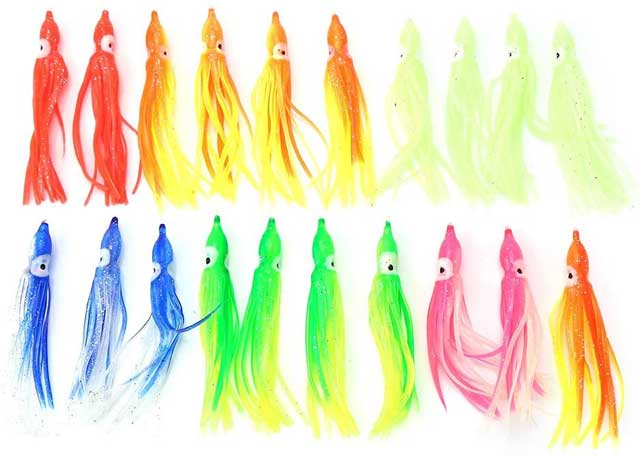
VGEBY Artificial Soft Octopus Trolling Skirts
There are plenty of great trolling lures on the market. Trolling lures don’t necessarily appear to be great fishing lures, however, when brought through the water at high speeds, they can catch some awesome offshore fish.
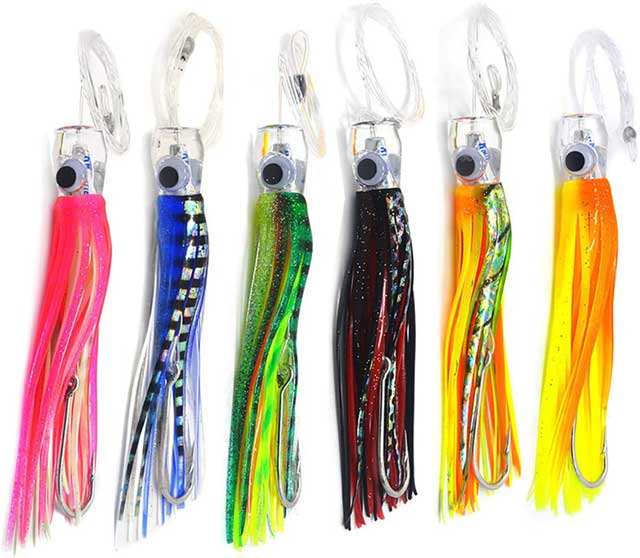
The best gear for trolling is generally conventional rods and reels. A heavy 6-7 foot conventional rod paired with a size 30-50 conventional reel is ideal. I usually spool my trolling reels with 50-80 pound braided line because there is very little stretch in braid. This allows for better hookups, especially on fish that strike a long way from the boat.
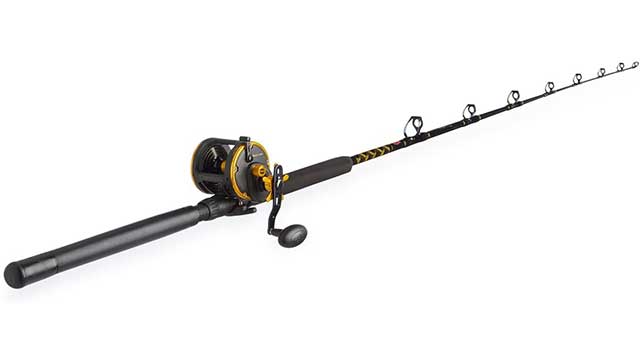
PENN Squall Level Wind Reel & Rod Fishing Combo
I’ll use a 15-20 foot, 40-60 pound fluorocarbon leader or 2-4 foot steel leader depending on what I’m targeting. If I’m going for mahi and sailfish, fluorocarbon is good. But if I’m trying to catch kingfish and wahoo, both of which have razor sharp teeth, a steel leader is necessary.
Leaders and line I love for trolling in the Keys:
- Favorite braided line: Power Pro Spectra Fiber Braided Fishing Line
- Favorite leader: Seaguar Blue Label 50 Yards Fluorocarbon Leader
- Steel leader for trolling: Drchoer 30Pcs Fishing Wire Leaders
When anglers are trolling, they should always keep an eye out for any type of disturbance on the surface or birds flying around above the water. Birds typically mean there’s bait in the area, and where there is bait there are pelagic gamefish.
Drifting
Drifting is a popular technique that can be used to catch numerous offshore species.
What is drifting?
Drifting is simply getting to a certain water depth and allowing your boat to drift through an area, preferably around some type of cover, like floating grass.
How deep should you drift in the Keys?
I prefer a depth of anywhere 500 feet or deeper and often make my decision based off how much grass and other cover is in the water. This is a great technique to use when trolling isn’t working and you want to give the fish a slower, more finesse approach.
What are the best baits and rigs for drift fishing the Keys?
When I’m drifting offshore, I like using both live and dead baits. My go to picks are:
- Live or dead mullet,
- threadfins,
- sardines, and
- ballyhoo
I’ll usually deploy multiple live baits and multiple dead baits until I get a couple bites on one or the other.
I rig my drifting baits on a 3/0-6/0 circle hook, depending on the size of the bait, and free line the bait with no weight. I use the same rods, reels and line for drifting that I do for trolling. This tactic can produce mahi, kingfish, wahoo, sailfish, tuna and among other species.
Pitching
Pitching is another offshore fishing technique that is often used for catching mahi.
What is pitching?
Pitching involves finding some type of floating cover offshore, like grass, wood pallets, trash cans, or any other type of debris. This cover might be holding bait and if it is, it’s likely holding mahi or some other type of gamefish as well.
Once anglers locate some type of floating cover, they usually spend a few minutes chumming the water with frozen bait and make a few casts towards the structure. If nothing happens and no fish appear fairly quickly, anglers should abandon that area and try to find other cover.
Anglers can use the same assortment of live or dead baits that I mentioned for drifting. Cut bait is also a good option for this technique.
When pitching, I prefer using heavy spinning gear. A 7’ rod paired with a 6000 sized reel. I spool the reel with 30-40 pound braided line and tie a 30-50 pound fluorocarbon leader to my braid. I’ll downsize my leader is the fish are being finicky and aren’t wanting to eat my baits with larger leader.
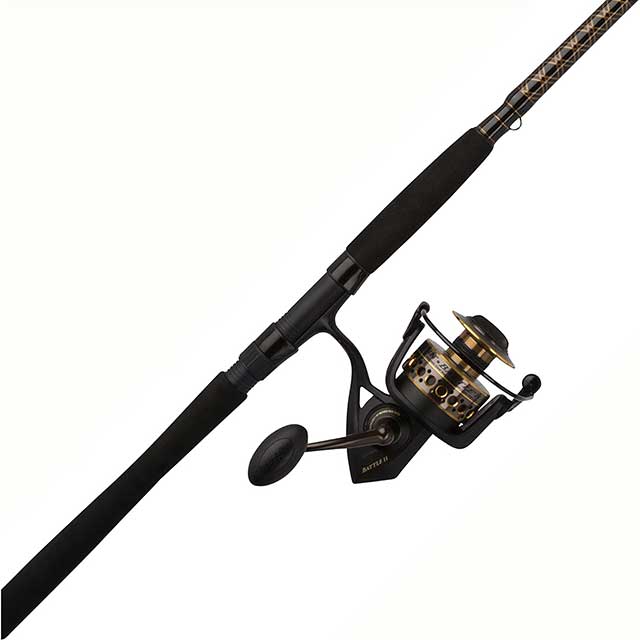
Pitching can be uneventful at times, but when anglers do come across cover with fish on it, it can be extremely rewarding.
I can vividly recall a day my dad and I were fishing offshore in the Keys with some friends. We were targeting mahi and we’d had a slow day. As we began making our way in, we spotted a piece of plastic with birds flying all around it. We quickly rode over to the debris to find literally hundreds of mahi swimming around underneath it.
Throughout the next two hours, we caught well over fifty mahi. We could have kept catching them but didn’t have enough ice to keep the fish we kept cold. It was an unbelievable experience getting to see and catch that many mahi in one single area.
Bottom Fishing
Bottom fishing is another fun way to catch a whole different variety of fish species in the Florida Keys. All kinds of snapper, grouper and even sharks are plentiful to anglers when bottom fishing.
What is bottom fishing?
When anglers are bottom fishing, they use a heavy weight to keep their bait in constant contact with the bottom.
Anglers can bottom fish over a wide range of structure, whether it’s a rockpile, a shipwreck, or just a sandy flat with not much structure around.
Depth finders are important for bottom fishing
It’s important to have a good depth finder and GPS system in order to find structure on the ocean floor. There are hundreds of coordinates online that are available to anyone. I would recommend finding a handful of these coordinates before taking a trip to the Keys, so you know of some likely areas to bottom fish at.
Best baits and rigs for bottom fishing the Keys
When I’m bottom fishing in the Keys, I use a variety of frozen and live baits. Everything from line pinfish and sardines, to frozen squid and threadfins. I like to use some of both until I figure out what the fish are biting best on that particular day.
I’ll usually use a 3/0 to 5/0 circle hook rigged with an egg weight. The deeper the water and the stronger the current, the heavier my weight is. For example, in mild current and 100 feet of water, I’d probably use a 3-ounce egg weight. In strong current and 100 feet of water, I’d probably go to a 5- or 6-ounce egg weight.
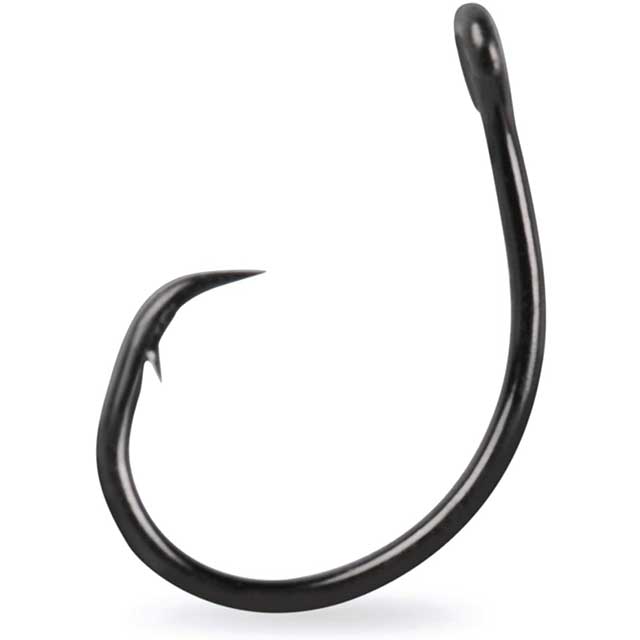
Mustad UltraPoint Demon Wide Gap Perfect In-Line Circle Wire Hook
Best rod, reel, and line for bottom fishing
I use both conventional and spinning gear for bottom fishing.
A medium heavy conventional rod paired with a size 30 reel is typically my go-to setup. I will typically spool my conventional setup with 40-60 pound monofilament line.
Penn Squall Lever Drag Combo
I also like using a heavy spinning rod paired with a 6000 sized reel.
Penn Battle II & Battle III Spinning Reel and Fishing Rod Combo
I spool my spinning setups with 40-50 pound braided line and tie a 40-80 pound fluorocarbon leader to that braid. The more structure I’m fishing around the bigger the leader I use.
Favorite braided line: Power Pro Spectra Fiber Braided Fishing Line
Favorite leader: Seaguar Blue Label 50 Yards Fluorocarbon Leader
Anchoring tips for bottom fishing the Keys
Anglers can either anchor their boat when bottom fishing or drift over the structure. I typically make my decision based on the weather conditions. In calm weather, I’ll usually drift over the structure once or twice to see if I can get a bite before I throw out the anchor. In rough conditions, it’s probably best to anchor so you can fish the structure effectively.
Reliable anchor for bottom fishing: Seachoice Deluxe Anchor
Reef Fishing
Reef fishing is another awesome way to catch snapper, grouper, and many other species in the Florida Keys. There are thousands of reefs in the Keys, both manmade and naturally occurring. Many of them are accessible to anglers and have coordinates that can be found online.
Reef fishing is similar to bottom fishing, however, when reef fishing, anglers aren’t always fishing right on the bottom. Anglers often use a technique known as chumming, which draws fish that are holding tight to the reef up closer to the surface. This is a popular technique for anglers who are targeting yellowtail, mangrove, and mutton snapper.
As mentioned above, anytime I’m fishing over some type of unseen structure under the water, a reliable GPS and fish finder are critical in order to find the exact location of the reef. Personally, I prefer some type of Garmin depth finder. It doesn’t have the be the fanciest, most expensive model, just something that will show you the depth, structure, GPS coordinates and fish.
Link to my favorite affordable depth/fish finder: https://amzn.to/3jNfpk4
Once, I’ve arrived at a reef, I usually graph the area once and see how many fish I can see on my depth finder and what the structure looks like. Then, I’ll drift over it a couple times to see if I can get a bite. If I do, I’ll drop my anchor and fish the spot thoroughly.
Link to a reliable anchor for bottom fishing: https://amzn.to/325FQLR
Once I’m anchored, I’ll often chum the water behind the boat. I use both store bought chum blocks, in addition to a homemade blend of oats and menhaden oil mixed with a little saltwater. You can buy menhaden oil at most bait shops in the Keys. The combination of the two chums is great for bringing all kinds of fish to the surface to feed. Yellowtail and mangrove snapper, Spanish mackerel and kingfish are among the most likely species to emerge off the bottom to feed on the chum.
When I’m reef fishing, I’ll usually have someone on the boat drop a bait to the bottom, while someone else chums and drops a bait back in the chum slick. I use live and frozen sardines, pinfish, and threadfins when fishing on the bottom at a reef. However, I prefer to use frozen shrimp when drifting a bait back into the line of chum.
I’ll tear the head and tail off the shrimp and rig the remainder of the bait onto a small, weighted hook that is made specifically for catching yellowtail. The bait rigged on this hook looks almost exactly like the chum that is slowly sinking towards the ocean floor. It’s my favorite technique for catching yellowtail snapper in the Keys.
Link to favorite yellowtail hook: https://amzn.to/3mFbYxR
If I’m fishing the bottom at a reef, I’ll use the same conventional rod and reel combo as I do for bottom fishing other types of structure. However, when I’m targeting snapper in the chum slick, I like to use a 7’ medium heavy inshore spinning rod paired with a 4000 sized reel. I spool that reel with 30 pound braided line and tie a 10-15 pound fluorocarbon leader to that braid.
I use such a light leader because snapper don’t have teeth and are typically very wary of heavy line. I’ll vary my line size based on weather conditions and water clarity. In fairly clear water on a sunny day 10-12 pound leader is probably best. Although you might get broke off a time or two, you’ll likely get way more bites with that lighter leader.
Link to my favorite spinning rod/reel combo for reef fishing: https://amzn.to/34NbjnS
Link to favorite braided line: https://amzn.to/34NJf3S
Link to favorite leader: https://amzn.to/3ogIecb
Bridge Fishing
The Florida Keys is home to hundreds of bridges that connect each of the islands to one another to create one land mass. Fishing under and around these bridges is a technique that many anglers use when targeting many species of fish, such as tarpon, grouper, and sharks. Bridges provide a shelter for these fish. They also tend to hold a lot of bait, which provides a food source for these predator fish.
Typically, when I’m bridge fishing in the Keys, I’m targeting tarpon. During the late spring and into the summer, massive schools of migratory tarpon swim underneath these bridges and feed schools of baitfish. This is a great time for anglers to take advantage of these feeding tarpon and try to their luck at catching one.
Catching one of these giant tarpon is no easy task. Tarpon can be very finicky and not want to bite. Even if anglers are able to trick one into biting, getting one of these giants to the boat is another story. Most of these bridge tarpon weigh anywhere from 50-200 pounds and can reach lengths of up to 6 feet. They are extremely powerful and can break your line in the blink of an eye.
When I’m tarpon fishing underneath bridges, I’ll usually start by looking for a fish to roll on the surface. If I can spot a couple of tarpon feeding on top of the water, then I’ll try to anchor my boat in that general area. I’ll anchor in front of an opening in the bridge and in a way that the current will take my bait behind the boat. Once I’m anchored, I’ll begin deploying baits towards the structure.
Some of the best tarpon baits include live blue crabs, live mullet, and live pinfish. If I run out of live bait, allowing a dead bait to sit on the bottom is another reliable option. You can buy these baits are most bait shops in the Keys or attempt to catch your own bait. I rig my baits up on a large 5/0-7/0 circle hook and position a large cork about 3-4 feet above my hook. This allows my bait to remain evaluated in the water column and stay in the tarpon’s strike zone.
I like using heavy spinning gear for tarpon fishing. Usually a 7’-8’ rod paired with a 7000 sized reel. I spool the reel with 50-pound braided line tied to a 60-80-pound fluorocarbon leader. Larger leader is necessary because of fishing around heavy structure.
My favorite rod/reel combo for tarpon fishing: https://amzn.to/2TRXj6a
Tarpon fishing can be very slow at times, as anglers are often doing good to get one or two bites an outing. However, it can also be very rewarding when you finally land one of these beautiful fish and experience the thrill of battling it.
Flats Fishing
Flats fishing is another popular type of fishing in the Florida Keys. Fishing in water just a few feet deep, anglers have a chance to catch bonefish, permit, tarpon, and snook, among other species. The Keys are full of tons of shallow backwater, where many of these species call home.
When flats fishing, anglers should look for points, potholes, rocks, current breaks, activity on the surface, tailing fish, and baitfish. All of these are high percentage areas where fish might be hiding while they wait on a meal to pass.
Fly fishing is often a popular way to fish the flats of the Keys. However, I prefer using spinning tackle when flats fishing. I like a 7’ medium, fast action rod paired to 3000-4000 sized reel. I spool the reel with 10-20 pound braided line tied to a 20-40 pound fluorocarbon leader. If I’m targeting bonefish and permit I’ll go with a lighter leader. However, if I’m going for tarpon or snook, I’ll need to use a heavier leader because of these specie’s abrasive jaws that can easily snap light leader.
Favorite rod/reel combo for flats fishing: https://amzn.to/3n1yrWb
Artificial lures are typically the way to most anglers target fish when flats fishing. A variety of jigs, paddle tail swimbaits, and soft-plastic jerkbaits are among some of the best options.
My favorite jig for bonefish/permit: https://amzn.to/2GtopNQ
My favorite paddle tail for snook/tarpon: https://amzn.to/386mPg2
My favorite soft-plastic jerkbait: https://amzn.to/38l9kcP
Back to You
Now that you know more about the outstanding fishing that the Florida Keys has to offer, be sure to plan a trip down there in the near future. No matter what time of year you decide to go, there is always great fishing in the Keys. I hope this guide helps you catch more fish if you do make a trip to the Keys. It’s a place I’d recommend all fishermen visit at some point. Thanks for reading!
